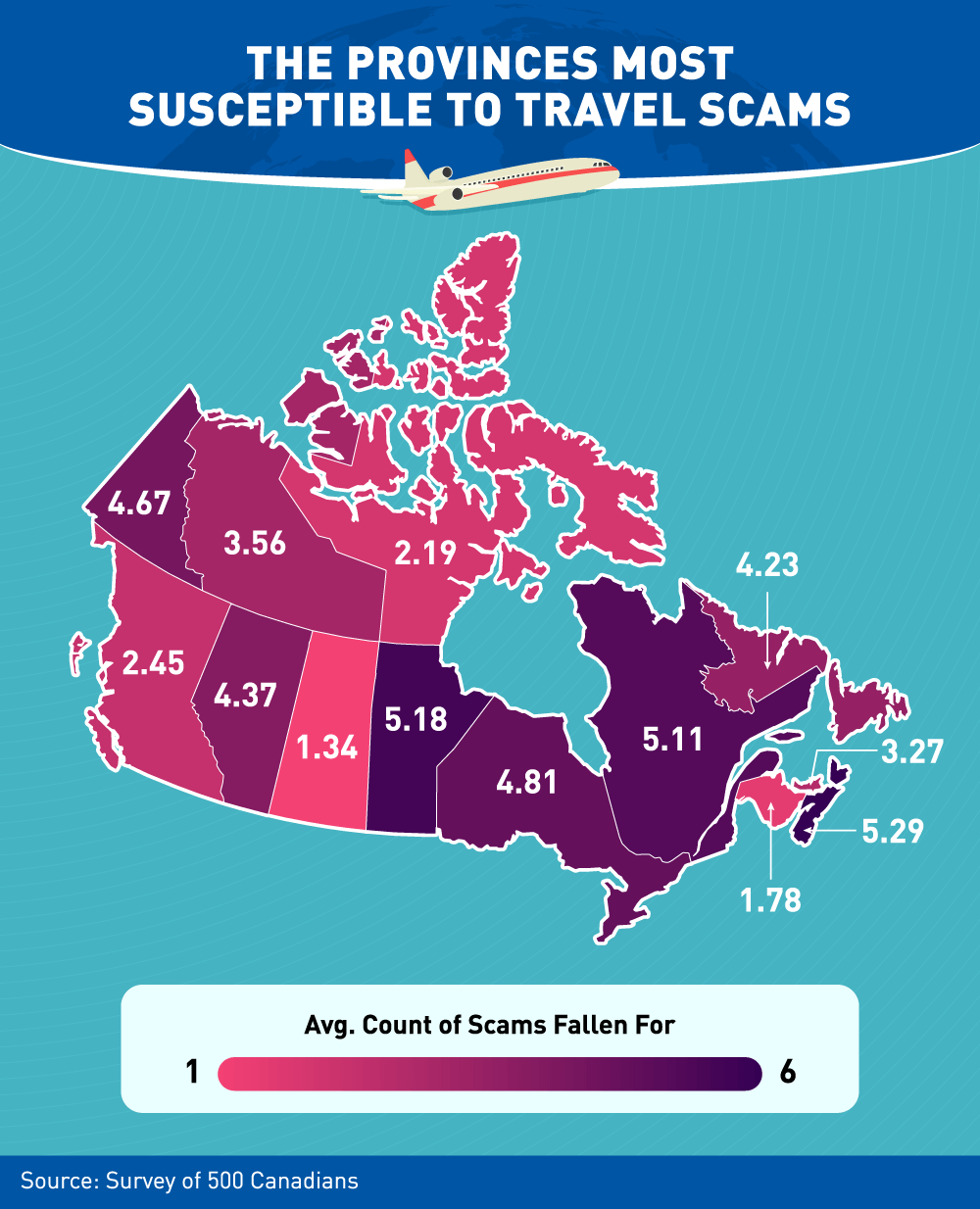Exposing the Dark Side of Travel: Study Reveals the Most Common Scams by Region
Traveling is a passport to the stunning landscapes, vibrant cultures, and heartwarming people that decorate our world. But as magical as the journeys we take may be, there is a dark side to them: the potential to fall victim to a travel scam.
From scammy cab drivers to pickpocketing, scams targeting tourists abound worldwide. But where are certain scams the most prevalent? And who is most likely to fall victim to them? We surveyed 1,000 Americans and 500 Canadians to find out the answers to these questions and more. So, buckle up, fellow travelers, as we take a wild ride through the most common traps set by crafty con artists, armed with the stats to prove it!
The Dark Side of Travel: Unmasking the Most Common Scams
Put your tray tables up and be sure those seats are in the upright position. Here are the most frequently encountered travel scams you may face on your adventures:

Close to half of travelers (46%) have been tricked into paying too much for food or drinks while begging or ”help” scams have duped 34% of tourists. This trick is nothing more than when the scammer assumes the role of a beggar or a desperate soul in need, to take advantage of sympathy. Pickpocketing, an age-old tactic, has caught 21% off guard.
Transportation is not immune either, with taxi scams accounting for 18% of travel scams. Drivers may charge higher-than-normal rates, take longer routes, or manipulate the meter. The lure of free or cheap tours has proven irresistible to 17% of travelers, who later discovered the hidden costs.
And let’s not forget the seemingly ”helpful” stranger. Locals will offer to help you with directions, carry your bags, or hail a taxi, then demand an exorbitant fee for their services, fleecing 16% of travelers out of their hard-earned money.
Fake charity scams have caught 11% of travelers off guard. Meanwhile, the flirtatious local and the friendship bracelet scams have each wooed 10% of tourists.
The flirtatious local plays out when a stranger strikes up a conversation, makes you feel good, and invites you to a local bar or club. The next thing you know is a monstrous bill you must pay. A friendship bracelet is when a stranger appears offering you a free bracelet, but before you can say no, they’ve tied one around your wrist. And surprise, the stranger demands payment for it or even uses the opportunity to pickpocket you.
Be careful with your cash. Tricks with wrong change or exchanging money fool 9% of travelers.
From Coast to Coast: The Travel Scam Preying on Residents of Each State
Travelers from every corner of the United States have experienced the bitter taste of scams during their overseas adventures, and each state has its own peculiar brand of trickery. Here are the most common scams US residents from each state have experienced while traveling:

In the south, Alabama’s globetrotters have been charmed by the flirtatious local scam, a trick also common among Idaho and New Jersey’s explorers. Meanwhile, the ”helpful” stranger has caught Alaskans, Arizonans, and the good folks of New Hampshire and North Dakota.
Arkansas and Michigan travelers, on the other hand, have been stung by money exchange scams. No-good pickpockets have ripped people from California, Florida, and several other states from Hawaii to Wisconsin.
Colorado, Connecticut, Nebraska, New York, and Virginia residents are most prone to taxi scams. While those who reside in Delaware, Georgia, Iowa, Kentucky, Massachusetts, Oklahoma, and Washington are most likely to find themselves overpaying for food and drink. Overall, the range of scams is as vast and diverse as the country itself.
Ranking the Most Vulnerable States To Travel Scams
From sea to shining sea, scams come in as many flavors as our 50 states. However, residents of some states seem to be more like all-you-can-scam buffets for these crafty con artists. Here is the average number of travel scams residents of each state claim they’ve fallen for:

On average, Indiana residents top the list, having fallen victim to travel scams a staggering 5.20 times on average, followed by Connecticut and Nebraska at 4.50 times. Not far behind, Kentucky reports an average of 4.25 scams per traveler, with Montana also sitting high on the list with an average of 4.66 scams.
On the brighter side, some states appear to navigate the risky landscape of travel scams with more prowess. For instance, residents of Hawaii, South Dakota, and Vermont have experienced the fewest number of scams, each with an average of just 1.00 per resident.
However, the sobering truth is that no one is truly immune. In fact, a shocking 52% of Americans have either lost money to travel scams or know someone who has, with the average amount lost totaling a hefty $380.
The Travel Scam Exploiting Residents of Each Province and Territory in Canada
Canadians are not immune to the sting of scams during their international exploits, and it appears that each province and territory has a unique scam it is most likely to fall victim to. Here are the most prevalent scams that Canadian residents from each province and territory have encountered while journeying abroad:

Residents of Alberta, Ontario, and Yukon are most susceptible to pickpocketing during their international travels. On the other hand, residents from British Columbia, Northwest Territories, and Nova Scotia are more likely to fall victim to scams involving exorbitantly priced food or drinks. In these instances, travelers are often unknowingly led to restaurants or bars where the prices are significantly higher than average, and they only realize it once they’re presented with the bill.
Other scams highlighted include the “found” ring scam most prevalent in Manitoba, money exchange scams in New Brunswick, the “helpful” stranger scam in Newfoundland and Labrador and Nunavut, taxi scams in Prince Edward Island, and begging or “help” scams most likely to trick residents of Quebec and Saskatchewan.
The Provinces Most Vulnerable to Travel Scams
While each province has its own experience with scams, some are more susceptible than others. Here is the average number of travel scams residents of each province report they’ve succumbed to:

Leading the ranking with the highest average count of scams experienced is Nova Scotia, with residents falling for an average of 5.29 scams. It’s closely followed by Manitoba, with an average of 5.18 scams, and Quebec, with an average count of 5.11.
At the other end of the spectrum, residents of Saskatchewan seem to be the least prone to falling for travel scams, with an average of just 1.34 scams reported, followed by New Brunswick, where residents reported an average of 1.78 scams. Other provinces, including Alberta, Newfoundland and Labrador, Ontario, and Yukon, fall somewhere in the middle, with average scam counts ranging from around 4.23 to 4.81.
Around the Globe: The Most Frequent Travel Scams by Region
Let’s walk the ‘Hall of Fame’ for the craftiest, slickest worldwide travel scams that have duped our fellow citizens, broken down by global region:

For Americans venturing to Australia and Oceania, the scam most frequently encountered is the flirtatious local. In the Caribbean, Central & South Asia, and the Middle East, however, unsuspecting travelers are more likely to be caught by begging or ‘help’ scams.
Central America, Northern Europe, South America, Southern Europe, and Western Europe, on the other hand, are hotbeds for pickpocketing.
Travelers navigating the bustling streets of Eastern Europe, Northeastern Asia, Northern Africa, and Southeastern Asia should be wary of taxi scams, the most prevalent hustle in these regions.
Americans traveling on their home continent are not immune either, with overpriced food or drinks reigning as the most common scam. Southern Africa stands alone, with the fake charity scam being its most frequently reported trickery.
A deep dive into the data reveals that Southern Europe, Western Europe, the Caribbean, South America, and Central America have been particularly challenging regions for American travelers, with scams reported more frequently in these areas.
Methodology
In May 2023, we surveyed 1000 and 500 Canadians about their experience with common travel scams. The average age of the respondents was 37 years old. 51% of the respondents were male, 47% female, and 2% identified as non-binary or other.
Fair Use
Want to use our sweet data or eye-catching infographics in your own article? Be our guest! All we ask is that you include a link back to this page with proper attribution. Deal? Cool. Can’t wait to see what you come up with.
